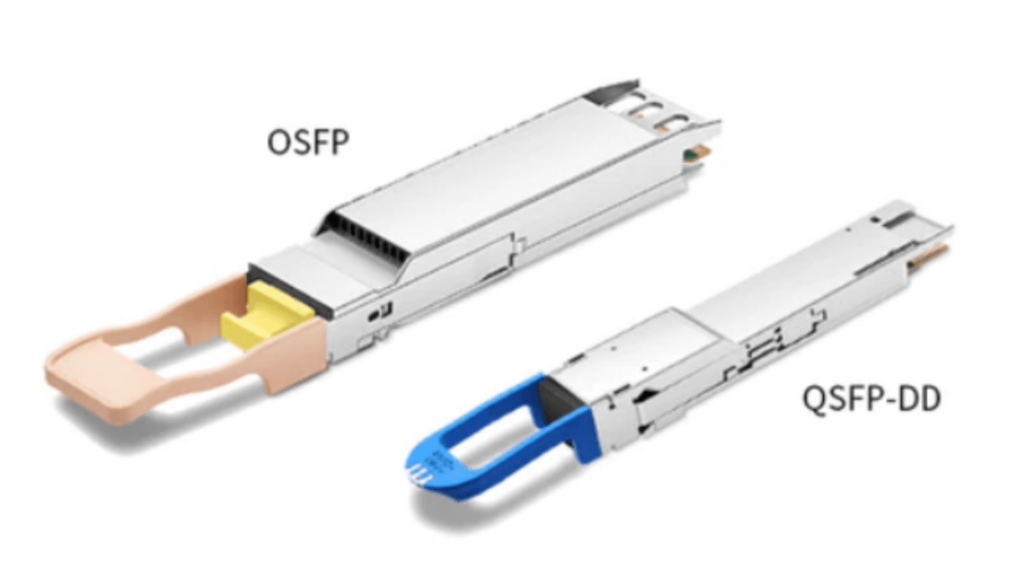In today’s fast-paced world, the need for high-speed data transfer has reached unprecedented levels.The emergence of AI applications and big models has made arithmetic a key infrastructure for the AI industry. As the need for faster communication continues to grow, high-speed optical modules have become an important component of AI servers.
1.Evolution of 800G Optical Modules
Optical modules undertake the task of converting optoelectronic signals in network connections, responsible for converting electrical signals into optical signals at the transmitter end, and then converting the optical signals into electrical signals at the receiver end after transmission through optical fiber.
With the development and integration of optoelectronic devices, their performance and transmission bandwidth continue to improve, optical modules need higher transmission rates and smaller size to adapt to different use scenarios. Packaging methods also continue to evolve, with smaller packages and power consumption meaning that optical modules have higher port densities on the switch and the same amount of power can drive more optical modules.
Increasing bandwidth requirements
The growth in bandwidth demand has had a significant impact on high-speed optical modules. With the emergence of emerging technologies and the need for large-scale data transmission, traditional 100G, 200G, 400G optical modules can no longer fully meet market demand. In order to meet the growing demand for bandwidth, 800G optical modules are becoming the trend.
Growth of LPO technology
In the era of 800G optical modules, Linear-drive Pluggable Optics (LPO) technology stands out.LPOs utilize linear analog components in the data link without the need for complex CDR or DSP designs. With dramatically reduced power and latency compared to DSP solutions, LPOs are ideally suited for the short-range, high-bandwidth, low-power and low-latency data connectivity requirements of AI computing centers. LPO solutions, including 800G LPO, are expected to capture significant market share as cloud service providers expand their computing resources.
2.800G Optical Module Packaging
As technology continues to advance, the packaging form of optical modules has undergone a remarkable evolution. From the early GBIC package, to the smaller SFP package, and now 800G QSFP-DD and OSFP packages. This development trend not only reflects the continuous increase in the rate of optical modules, but also shows its progress towards miniaturization and hot-plugging. 800G optical modules are increasingly used in a wide range of application scenarios, covering a variety of fields, including Ethernet, CWDM/DWDM, connectors, Fibre Channel, and wired/wireless access.
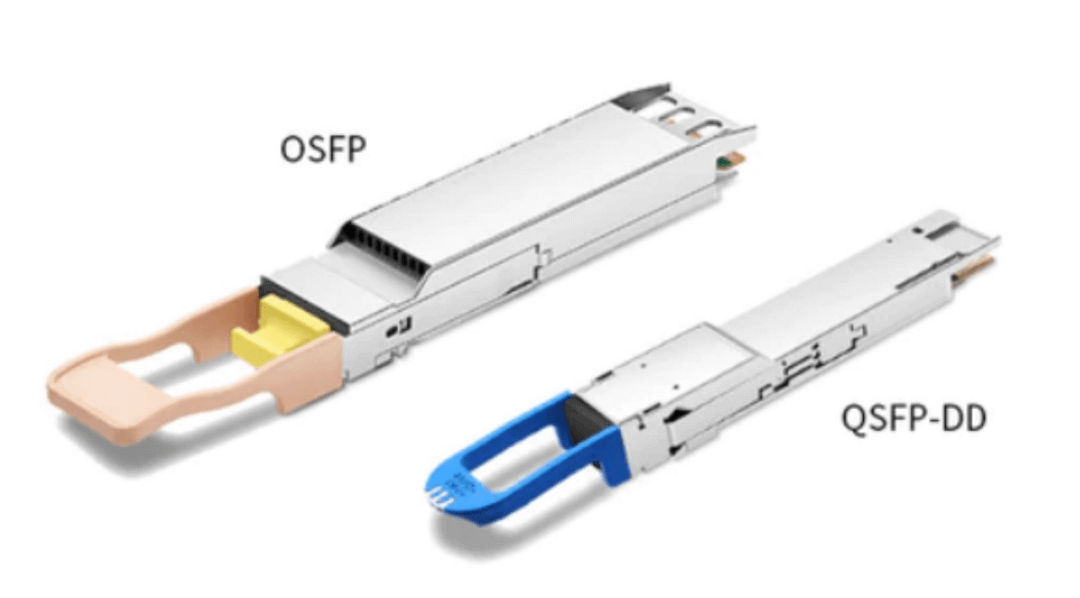
800G QSFP-DD Form Factor
Dual-density quad-channel small form factor pluggable high-speed modules. the QSFP-DD is the package of choice for today’s 800G optical modules, enabling data centers to efficiently grow and scale cloud capacity as needed. the QSFP-DD module features 8-channel electrical interfaces at rates of up to 25Gb/s (NRZ modulation) or 50Gb/s (PAM4 modulation) per channel, providing up to 200Gb/s or 400Gb/s aggregation solutions.
Benefits of 800G QSFP-DD
1. Backward compatible with QSFP+/QSFP28/QSFP56 QSFP packages.
2. 2×1 stacked one-piece cage connectors to support single and dual-height cage connector systems.
3. SMT connectors and 1xN cage enable at least 12 watts of thermal capacity per module. Higher thermal capacity reduces the heat dissipation function requirement of the optical module, thus reducing some unnecessary costs.
4. In the design of QSFP-DD, the MSA working group has fully considered the flexibility of the user’s use by adopting an ASIC design that supports a variety of interface rates and is backward compatible (compatible with QSFP+/QSFP28), thus reducing the cost of the ports and the cost of equipment deployment.
800G OSFP Form Factor
OSFP is a new type of optical module, much smaller than CFP8, but slightly larger than QSFP-DD, with 8 high-speed electrical channels, each 1U front panel still supports 32 OSFP ports, with integrated heat sinks can greatly improve heat dissipation performance.
Advantages of the 800G OSFP
1. OSFP modules are designed with 8 channels to directly support up to 800G of total throughput, resulting in higher bandwidth density.
2. Since OSFP packages support more channels and higher data rates, they can provide higher performance and longer transmission distances.
3. OSFP modules have an excellent thermal design and can handle higher power consumption.
4. OSFP is designed to support higher rates in the future. Because of the larger size of the OSFP module, it is possible to support higher power consumption and thus higher rates, such as 1.6T or higher.
800G Optical Module Form Factor Comparison:
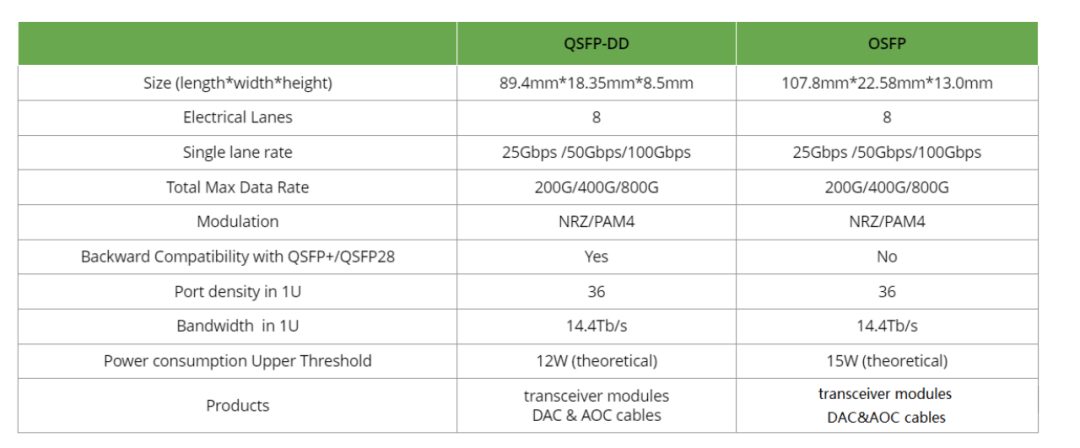
QSFP-DD is usually preferred in telecom applications, OSFP is more suitable for data center environments. The main difference between the two is:
1) Size: OSFP is slightly larger in size.
2) Power consumption: OSFP consumes slightly more power than QSFP-DD.
3) Compatibility: QSFP-DD is perfectly compatible with QSFP28 and QSFP+, while OSFP is not.
3.Types of 800G Optical Modules
800G=8*100G=4*200G, so according to the single-channel rate can be divided into two categories, i.e., single-channel 100G and 200G. the corresponding architecture is shown in the following figure. Single-channel 100G optical modules can be realized quickly, while 200G has higher requirements for optical devices. Since the current maximum rate supported by the electrical interface is 112Gbps PAM4, for single-channel 200G, a gearbox is required for conversion.
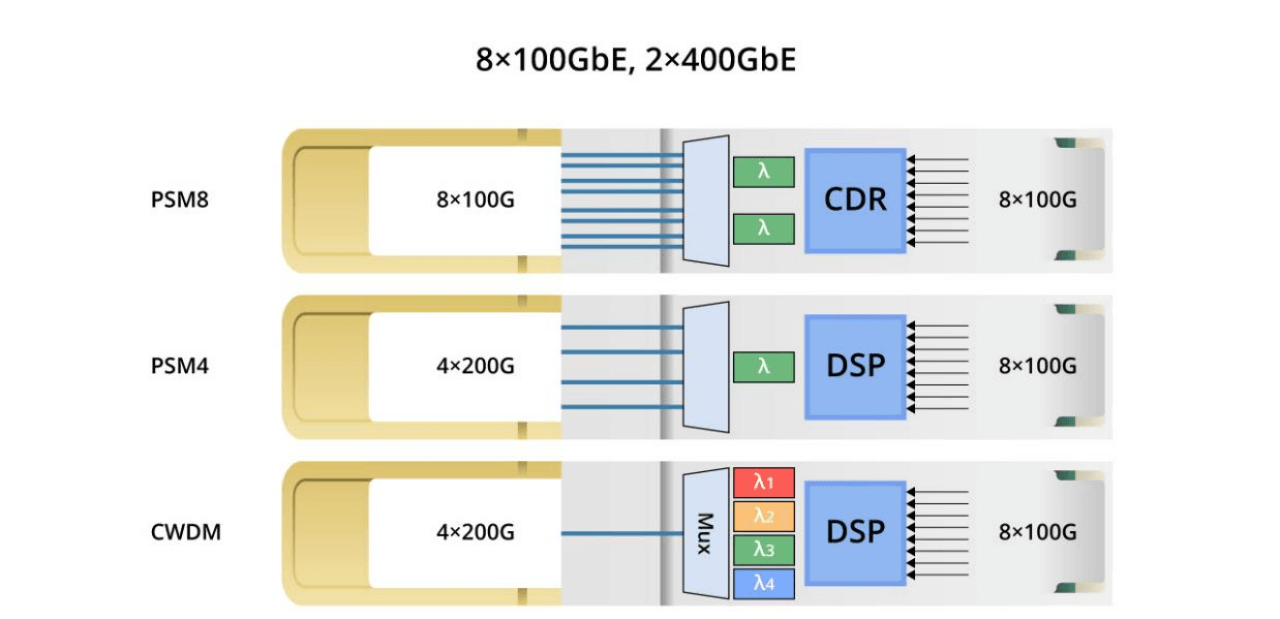
For the multimode case, there are two main standards for 800G optical modules, corresponding to transmission distances less than 100m.
800G SR8
It uses a VCSEL scheme with a wavelength of 850nm and a single channel rate of 100Gbps PAM4, which requires 16 fibers. This can be seen as an upgraded version of the 400G SR4 with double the number of channels. Its optical interface is MPO-16 or 2 rows of MPO-12 as shown in the figure below. 800G SR8 optical modules are generally used for 800G Ethernet, data center links or 800G-800G interconnects.

800G SR4
The solution uses 850nm/910nm wavelengths for bi-directional transmission, utilizing DeMux in the module to separate the two wavelengths. The single-channel rate is 100Gbps PAM4 and requires 8 fibers. Compared with SR8, the number of fibers in this scheme is reduced by half. Its block diagram is shown below:
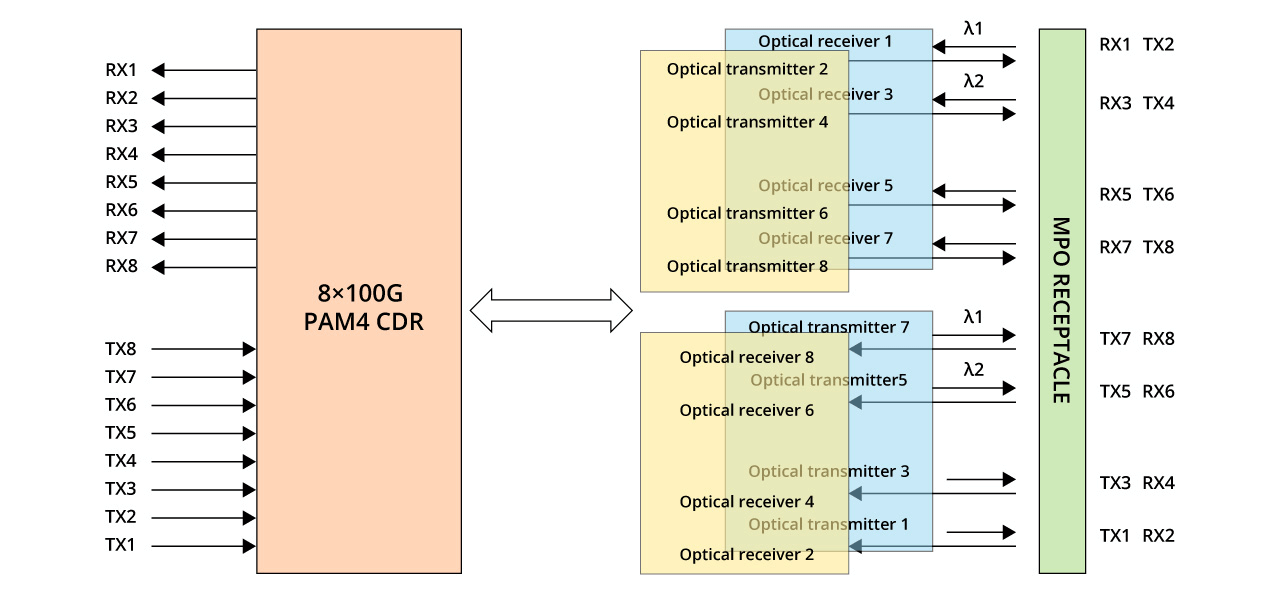
Its fiber optic interface is shown below with MPO-12 interface.
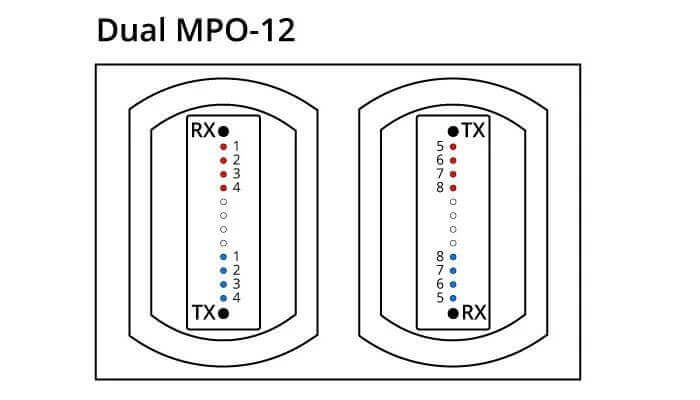
For the single-mode case, there are various standards for 800G optical modules.
800G DR8、800G 2xDR4 and 800G PSM8
These three standards have similar internal architectures, all of which are 8 transmitters and 8 receivers, with a single channel rate of 100Gbps, requiring 16 optical fibers.
The 800G DR8 optical module adopts 100G PAM4 and 8-channel single-mode parallel technology, with a transmission distance of up to 500m over single-mode fiber, and is typically used in data centers, 800G-800G, 800G-400G, and 800G-100G interconnects.
800G PSM8 adopts CWDM technology with 8 optical channels, each with a transmission rate of 100Gbps, supporting a transmission distance of 100m, which is ideal for long-distance transmission and fiber resource sharing.
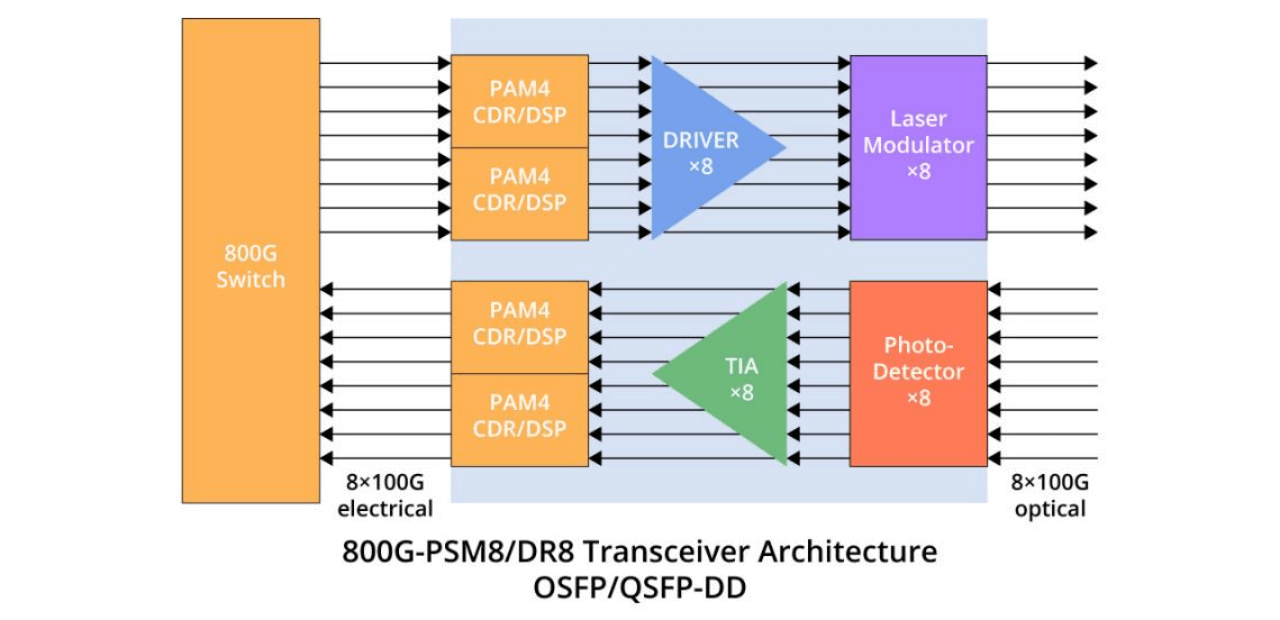
800G 2DR4 refers to two “400G-DR4” interfaces, 2DR4 optical interface is two MPO-12, as shown in the figure below, can be interconnected with 400G DR4 optical module, no fiber branch cable, support 500m transmission distance, convenient for data center upgrades.PSM8 and DR8 optical interface is MPO-16. MPO-16.

800G 2xFR4 and 2xLR4
Both standards have a similar internal structure and contain 4 wavelengths with a single channel rate of 100 Gbps. the number of fibers is reduced by Mux, which requires 4 fibers, as shown in the figure below.
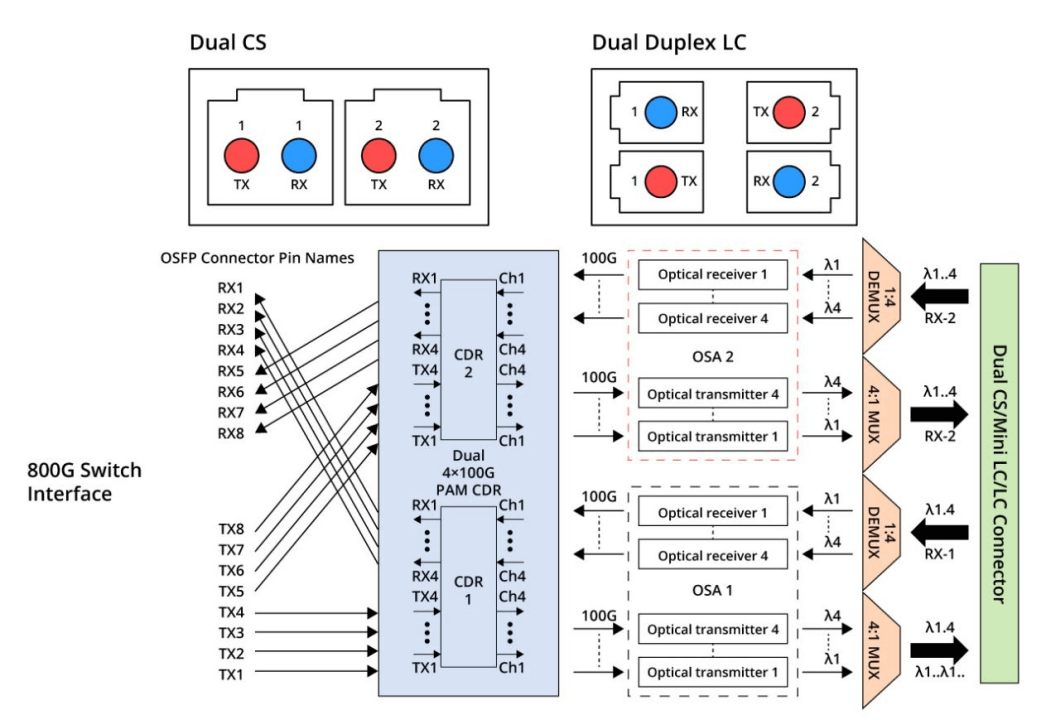
These two solutions are upgrades of 400G FR4 and LR4 optical modules using CWDM4 wavelengths of 1271/1291/1311/1331nm. 2xFR4 supports transmission distance of 2km, and 2xLR4 supports transmission distance of 10km. their optical interfaces are either dual CS or dual duplex LC interfaces.
800G FR4
This solution uses four wavelengths with a single channel rate of 200Gbps and requires two fibers to support a transmission distance of 2km, as shown below.
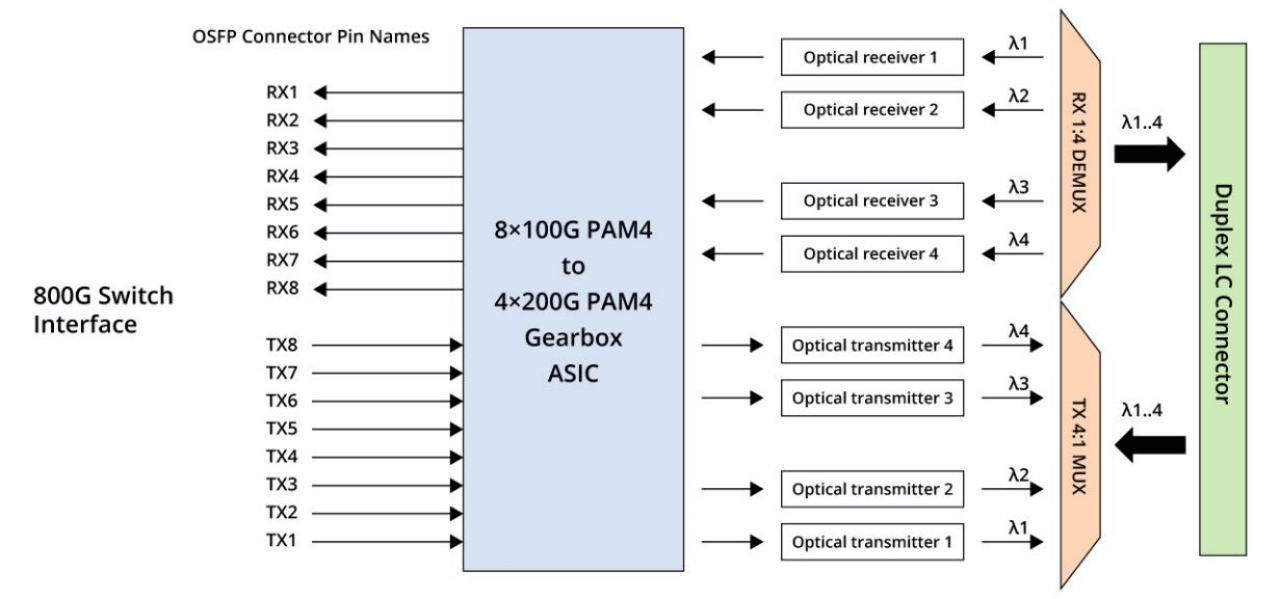
It uses a duplex LC optical interface as shown below.
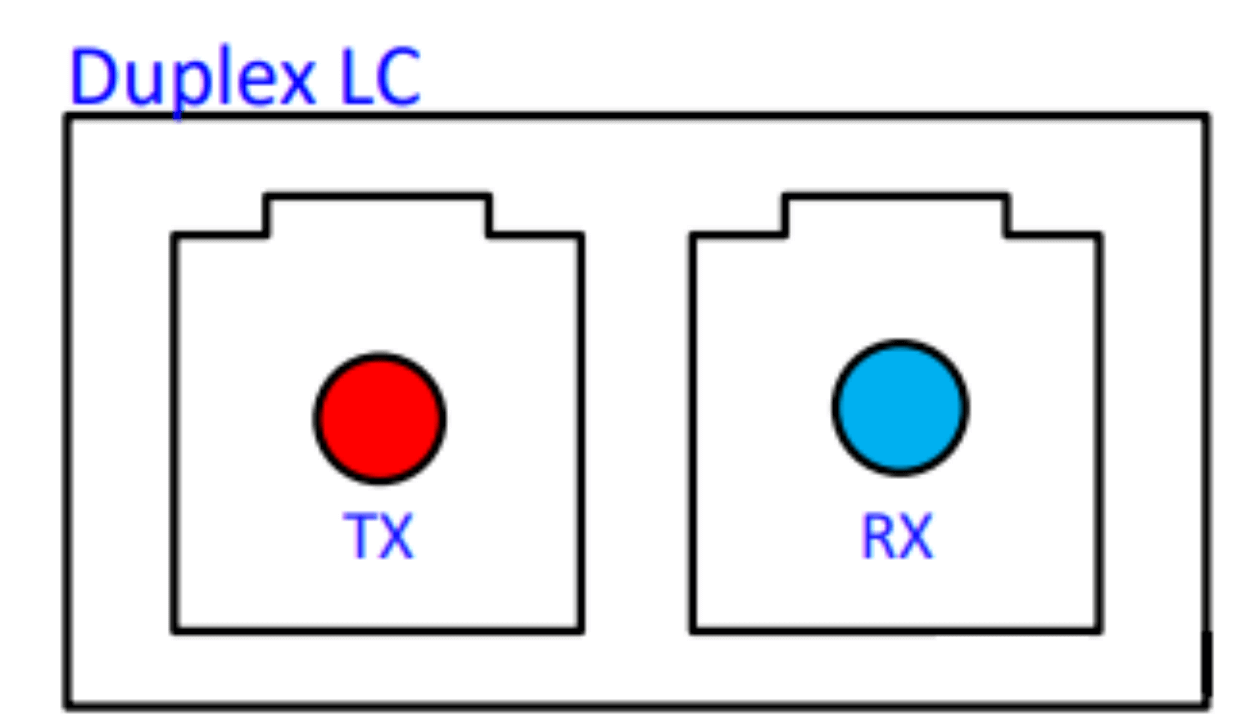
800G FR8
The solution uses eight wavelengths, each with a rate of 100Gbps, and requires two fibers to support a transmission distance of 2km, as shown in the figure below. The eight wavelength channels are 1271/1291/1311/1331/1351/1371/1391/1411nm.
4.Al’s Impact on 800G Optical Module Deployment
Why is 800G more important than 400G for AI servers?
First, AI servers require high data rates and low latency, requiring top-of-rack switches that match the underlying bandwidth. These switches may also require latency redundancy, which requires high-speed optical modules. For example, the NVIDIA DGX H100 server comes with eight H100 GPU modules, each of which requires two 200G optical modules. Therefore, each server requires at least 16 200G modules, and the corresponding top-of-rack switch ports require at least 4 pieces 800G.
Second, 800G optical chips are more cost efficient and economical. They use 100G EML chips, while 200G/400G use 50G optical chips. Data shows that one 100G optical chip costs 30% less than two 50G optical chips at the same rate.
Nonetheless, 400G optical modules remain significant in the industry. While they may not be able to match the speed of 800G optical modules, they offer a significant increase in bandwidth over older technologies and are the preferred solution for many organizations. Additionally, some applications may not need the full functionality of 800G Ethernet, making 400G Ethernet more practical for them.
As the demand for faster, more efficient data transmission continues to surge, the era of the 800G optical module has arrived. With superior bandwidth capabilities and advances in LPO technology, 800G optical modules are sure to revolutionize the AI industry and data centers.

